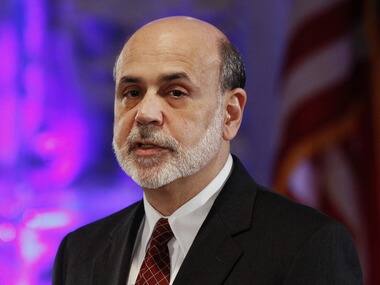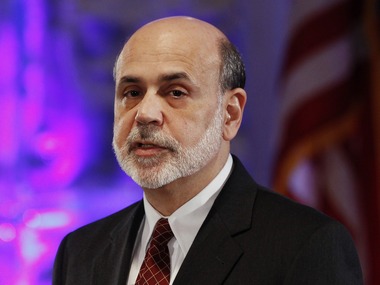Two years after the US recession the economy still looks weak. Economic growth is sluggish and the Federal Reserve has still not hinted at any plans for a further stimulus. On Wednesday the central bank lowered its outlook for the economy, but offered no monetary support, which led to a sharp fall in global stocks.
Fed Chairman Ben Bernanke said factors weighing on the economy, such as high commodity prices, should be fleeting but warned some of the weakness could linger. “Part of the slowdown is temporary and part of it may be longer lasting,” Bernanke told a news conference after a two-day policy meeting.
[caption id=“attachment_29923” align=“alignleft” width=“380” caption=“There is some hope the Fed will conduct another round of asset buying, but most economists see it as unlikely at this time. Reuters”]
 [/caption]
[/caption]
Without new information from the Fed, investors were left to take profits after a four-day rally that lifted stocks from three-month lows. Some analysts see range-bound trading ahead, with 1,295 among the S&P 500’s first targets of resistance.
Expectations about a second round of Fed stimulus last fall helped ignite an extended rally in stocks. There is some hope the Fed will conduct another round of asset buying, but most economists see it as unlikely at this time.
The Dow Jones industrial average slid 80.34 points, or 0.66 percent, to 12,109.67 at the close. The Standard & Poor’s 500 Index dropped 8.38 points, or 0.65 percent, to 1,287.14. The Nasdaq Composite Index tumbled 18.07 points, or 0.67 percent, tot 2,669.19.
The US central bank kept official interest rates at a historic low near zero and Bernanke signaled they will stay there through the end of the year or longer. The Fed estimated the economy should grow 2.7 percent to 2.9 percent this year, down from a forecast range of 3.1 to 3.3 percent made in April.
It also said it sees 2012 growth in a range of 3.3 percent to 3.7 percent, lower than its previous forecast.
In a statement, the central bank said a jump in commodity prices and supply-chain disruptions from Japan’s devastating earthquake had weighed on growth and pushed up prices, but that those factors should dissipate over time.
“The Fed knows it is in for a rough road ahead,” said Steve Blitz, senior economist at ITG Investment Research in New York. “At this moment the Fed is just like the rest of us, on the sidelines waiting to see what unfolds.”
The Fed confirmed it was ending its $600 billion bond-buying programme meat the end of June and reiterated it will continue to reinvest principal payments from its holdings.
By the time its latest “quantitative easing” programme wraps up next week, the Fed will have pumped some $2.3 trillion into the economy.
The Fed’s downbeat economic assessment weighed on stocks, which closed lower after four days of gains. Prices for US government bonds were nearly flat and the dollar edged up against the euro.
“There are no hints of further easing from the Fed,” said Nick Bennenbroek, head of Group of 20 forex strategy at Wells Fargo in New York. “The statement overall disappointed investors looking for more bearish language and that’s why we are seeing the dollar rally a little bit.”
Bernanke, in a wide-ranging question-and-answer session with reporters which touched on issues as diverse as Greece’s economic woes and the size of reserves that big banks should hold, conceded that US economic hopes were partly hostage to events in Europe.
“If there were a failure to resolve that (Greek debt) situation, it would pose threats to the European financial system, the global financial system, and to European political unity,” he said. “So yes, we did discuss it and it is one of several potential financial risks that we are facing now.”
Long crawl
The Fed on Wednesday downgraded its view of the labour market and pushed its forecast for unemployment a bit higher.
It said the jobless rate would likely average 8.6 percent to 8.9 percent in the fourth quarter of 2011. In April, it had forecast a range of 8.4 to 8.7 percent. By 2013, the Fed said joblessness would still be significantly above what it considers to be consistent with full employment.
The Fed’s inflation forecast was little changed at 2.3 percent to 2.5 percent for this year, but its projection of core prices, which strips out food and energy costs, moved up to a 1.5-to-1.8-percent range from 1.3 to 1.6 percent.
Policymakers at the Fed strive to keep inflation in a 1.7-to-2-percent range and the acceleration in core prices could complicate any desire to further support the economy.
In its statement, the Fed dropped any reference to core inflation, which it characterised in April as being “somewhat low.”
With the jobs outlook uncertain and home values falling, consumer spending - which makes up around 70 percent of US GDP- has lagged. Factory activity has been sluggish as well.
The economy grew at just a 1.8 percent annualiSed rate in the first three months of the year. Analysts expect growth of around 2 percent in the second quarter, still not sufficient to generate a big uptick in hiring.
The economy’s weakness has led to some speculation the Fed could take fresh steps to bolster the recovery.
While Bernanke did not rule anything out, he made clear the Fed does not feel the economy is in as dire a condition as it was last fall when it launched its latest bond-buying plan.
If it were pressed into action, the Fed chief said the central bank could buy more securities, lower the interest rate it pays to banks on reserves held at the Fed or even pledge to keep its balance sheet at a high level for an extended period.
Bernanke said the vow to keep interest rates exceptionally low is intended to suggest the Fed is at least two or three meetings away from a move, but that the time period could be “significantly longer” depending on the economy.
The Fed statement and press conference led more large bond firms put off expectations of rate hikes until the second half of next year.
Reuters
)